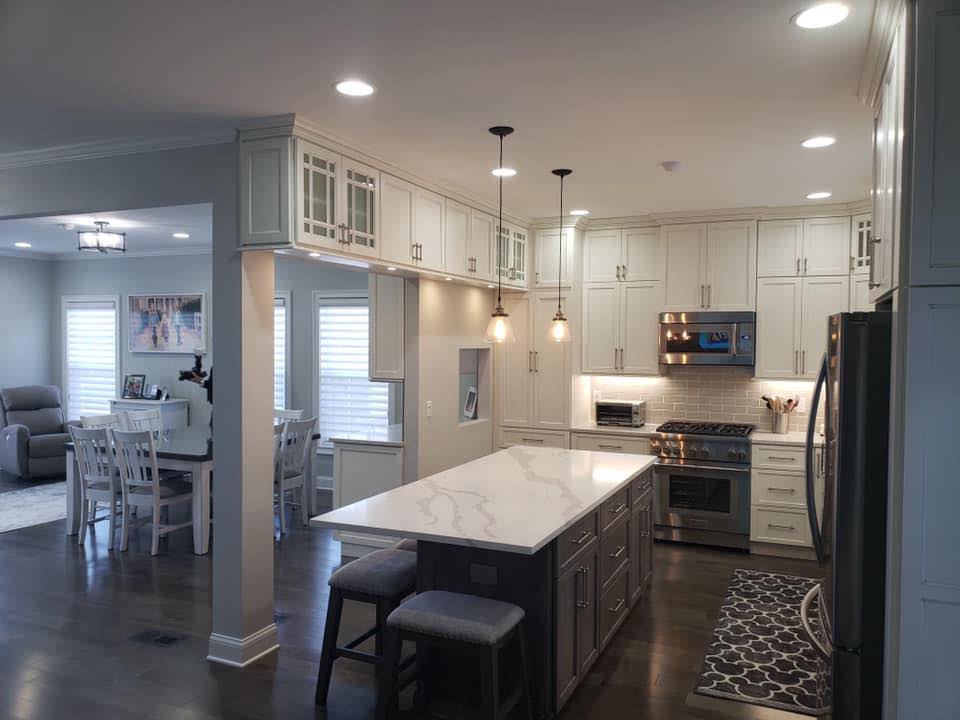At Timeline Remodeling, we understand that the kitchen is the heart of your home—a place where meals are prepared, conversations unfold, and memories are created. Choosing the right layout is one of the most important decisions when remodeling your kitchen. The debate between Open Concept vs. Closed Kitchens continues to be a hot topic, with each style offering unique advantages and challenges. In this comprehensive guide, we’ll break down both options to help you determine which is the perfect fit for your Central NJ home.
Understanding Open Concept Kitchens
An open concept kitchen eliminates walls or barriers between the kitchen and adjoining spaces, such as the dining or living room. This layout is a cornerstone of modern and contemporary home designs, promoting seamless integration between functional and social spaces.
Advantages of Open Concept Kitchens
- Enhanced Social Interaction
Open kitchens make it easy to interact with family or guests while cooking. Whether you’re hosting a gathering or helping your kids with homework, the openness fosters connection and inclusivity. - Spacious and Airy Feel
By removing walls, open kitchens feel larger and brighter. Natural light flows freely, creating an inviting atmosphere that enhances the overall home environment. - Modern Aesthetic
Open concept kitchens epitomize contemporary design, offering clean lines, sleek finishes, and a cohesive look that seamlessly blends with adjoining spaces. - Flexibility in Layout
Open layouts allow for versatile furniture placement and multifunctional features like kitchen islands, which can serve as dining tables, prep stations, or even workspaces.
Challenges of Open Concept Kitchens
- Lack of Privacy
In an open kitchen, everything—from cluttered countertops to cooking messes—is visible. Maintaining a pristine appearance can require extra effort. - Noise and Smells
Cooking sounds and aromas travel easily to connected areas, which may disrupt activities in the living or dining rooms. - Design Cohesion
Since the kitchen shares visual space with adjoining rooms, its design must align with the overall home aesthetic, requiring careful planning and coordination.
Understanding Closed Kitchens
Closed kitchens feature walls or partitions that separate the cooking area from other parts of the home. This traditional layout offers a private, self-contained space for meal preparation and other kitchen tasks.
Advantages of Closed Kitchens
- Privacy and Containment
Closed kitchens keep cooking messes, smells, and noise contained, ensuring that other parts of the home remain undisturbed. - Focused Functionality
The separation allows for a dedicated cooking space, free from distractions. This is ideal for serious cooks who prefer a more organized and efficient environment. - More Storage Opportunities
With more wall space available, closed kitchens provide ample room for cabinets, shelves, and other storage solutions, helping you keep the space tidy and functional. - Traditional Charm
Closed kitchens evoke a sense of coziness and intimacy, making them a popular choice for homeowners who favor a classic, structured design.
Challenges of Closed Kitchens
- Limited Interaction
Walls create a physical barrier, isolating the cook from social activities happening in the rest of the home. - Smaller Appearance
Closed kitchens can feel confined, especially in homes with limited square footage. - Less Natural Light
Without an open connection to other spaces, closed kitchens often rely on artificial lighting, which may reduce their overall brightness.
Factors to Consider When Choosing Your Kitchen Layout
- Your Lifestyle
- Are you someone who loves to entertain? An open concept kitchen may be perfect for hosting gatherings.
- Do you value privacy while cooking or prefer a quieter environment? A closed kitchen might suit your needs better.
- Available Space
- Smaller homes or apartments benefit from open kitchens, which make the space feel larger and more functional.
- Larger homes can accommodate closed kitchens without compromising the overall layout.
- Cooking Habits
- If you cook elaborate meals frequently and want to contain smells and messes, a closed kitchen is advantageous.
- Casual cooks who enjoy interacting with family while preparing meals often prefer an open concept.
- Design Style
- Modern and contemporary homes often favor open kitchens for their seamless integration.
- Traditional or vintage-inspired homes align well with the structured design of closed kitchens.
Blended Designs: Combining the Best of Both Worlds
If you’re undecided, a hybrid approach can offer the benefits of both layouts:
- Partial Walls or Glass Partitions
These options create a visual division while maintaining an open feel and allowing natural light to flow. - Sliding or Pocket Doors
Sliding doors can open or close the space as needed, offering flexibility for entertaining or privacy. - Zoned Layouts
Use rugs, lighting, or furniture to define kitchen boundaries within an open layout, creating the illusion of separate spaces.
Contact Timeline Remodeling for Your Dream Kitchen
At Timeline Remodeling, we understand that the right kitchen layout is a personal decision that impacts your daily life and the value of your home. Whether you’re drawn to the modern appeal of an open concept kitchen or the classic charm of a closed layout, our expert team can help you design a space tailored to your needs.
With over 25 years of experience serving Central NJ homeowners, we specialize in creating kitchens that blend functionality with style. From initial consultation to project completion, we’re here every step of the way to ensure your kitchen remodel exceeds expectations.
Ready to start your journey toward the perfect kitchen? Contact Timeline Remodeling today for a free consultation, and let’s bring your vision to life!

